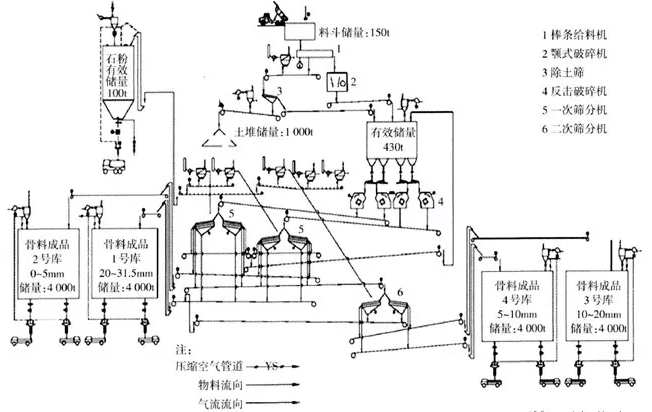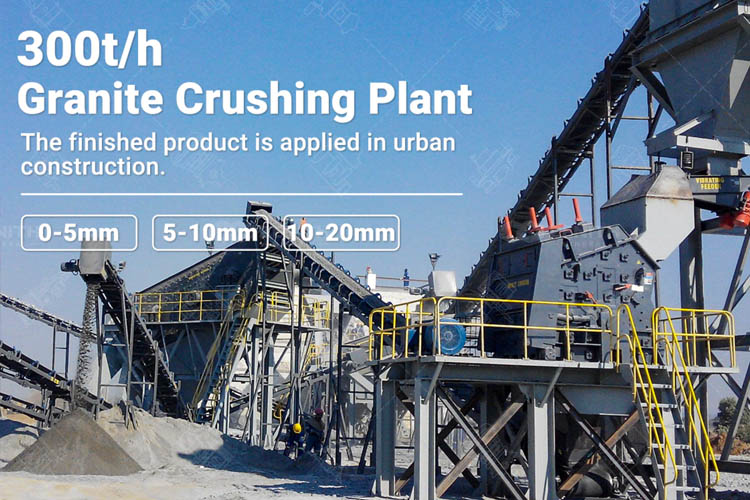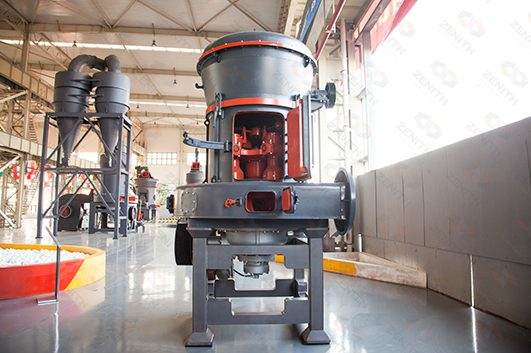In the crushing and sand making industry, limestone is one of the most common used raw materials. It is often used as a building material and is also an important raw material for many industries. Because of its wide distribution, limestone crushing &sand making lines are very common, with capacity ranging from hundreds to thousands of tons per hour.
This article takes the 1000t/h limestone aggregate line as an example to introduce the equipment selection, process flow, production line layout, dust treatment and other details of the sand and gravel aggregate line for reference.

The main component of limestone is calcium carbonate (CaCO3), with a general specific gravity of 2.7 (stone specific gravity, non-bulk density), medium hardness, and low abrasiveness. In China, limestone is widely distributed in 29 provinces, municipalities and autonomous regions, such as Shaanxi, Anhui, Guangxi, Sichuan (including Chongqing), Shandong, Hebei, Henan, Guangdong, Liaoning , Hunan, Hubei, Heilongjiang, Zhejiang, Jiangsu, Guizhou, Jiangxi, Yunnan, Fujian, Shanxi, Xinjiang, Jilin, Inner Mongolia, Qinghai, Gansu and so on.
There are mainly three types of commonly used crushers suitable for limestone:
One is jaw crusher + impact crusher;
The second is jaw crusher + cone crusher + vertical shaft impact crusher;
The third is hammer crusher + impact crusher.
In order to facilitate the subsequent quantitative explanation, we take an existing limestone mine in a cement factory as the background. The processing capacity of the production line is 1000t/h, 10% of the soil is removed, and the finished aggregate product is 20-31.5mm, 18%; 10-20 mm, 25%; 5-10 mm, 17%; 0-5 mm, 25%.
Considering the requirements of rock characteristics and product proportion, choose a two-stage crushing scheme, which is jaw crusher + impact crusher combination form. The main feature of this combination is that the product particle size is good, the stone powder is small, with low total investment, low energy consumption, moderate noise and dust on the environment.
Primary crusher adopts a jaw crusher with capacity 680~880t/h( discharge opening is 200mm), and the installed power is 250kW.
Secondary crusher adopts 4 impact crushers with capacity 300~350t/h(discharge opening is 40mm) and the installed power of each impact crusher is 250kW.
Screening adopts two-stage vibrating screen. The first stage screening adopts 4 3ykr3075 circular vibrating screen and the secondary stage screening adopts 2 2YKR3075 circular vibrating screen.
The aggregate is stored in 4 16m steel plate storehouses with bulk delivery machines under the storehouses.
Belt conveyor and bucket elevator are selected for conveying massive materials, and chain conveyor is used for conveying powdery materials.
The process flow includes the following units:
(1) Aggregate primary crushing and transportation;
(2) Aggregate soil removal, screening and transportation;
(3) Aggregate secondary crushing and transportation;
(4) Aggregate primary screening and transportation;
(5) Aggregate secondary screening and conveying;
(6) Storage and delivery of finished products;
(7) Powder conveying and bulk packing;
(8) Compressed air station and pipe network:
(9) Weighing system;
(10) Water supply and processing unit;
(11) Electrical automation system;
(12) Spare parts and maintenance center.
The project process is shown in the figure below:

1) Use the altitude difference of floor of site
The layout of the production line takes advantage of the floor altitude difference on site. The floor elevation of the primary crushing unloading platform is 243.60m, the floor elevation of the primary crushing and soil removal screening is 228.60m, and the floor elevation of all other units, including secondary crushing, primary screening, secondary screening and transportation, finished aggregate and transportation, is 217.00m.
2) Layout of belt conveyor
Considering the maintenance channels of each unit, the belt conveyor between each unit should be considered in the largest perspective, which saves investment and operating cost, and saves the site. The entire project covers only 2.1 * 104㎡.
3) Layout of crushing and screening equipment
The crushing and screening equipment are arranged on a layer of concrete frames, and are founded separately, which can reduce vibration, facilitate equipment maintenance, and reduce investment.
In consideration of the limited space, the finished materials of the primary and secondary screening units are transported to the finished goods warehouse by hoist. There is no buffer pile between primary crushing and secondary crushing, but only a 430T buffer bin. The disadvantage is that the equipment after the secondary crushing cannot continuously produce when the fault occurs in the primary crushing or the raw stone supply of the mine. Its advantage is saving millions of investment and venue.
4) Storage method of finished aggregate
There are four main storage methods for finished aggregate, which are concrete storage, steel plate storage, pile shed storage and open-air storage.
Open-air storage is rarely adopted due to severe dust pollution;
Compared with concrete storage, steel plate storage has the advantages of less investment and short-term construction period, but also has the disadvantages of short wear time and short life;
Compared with pile shed storage, steel plate storage has the advantages of good dust collection effect, small area, and automatic bulk delivery and so on.
Considering the factors such as project construction, investment cost, environmental protection, automation, the finished aggregate of this project is stored in 4 16m steel plate warehouses, under which bulk carriers are installed for delivery.
The environmental pollution of sand aggregate production mainly comes from dust pollution, water pollution and noise pollution. The production line uses a dry process, so there is basically no water pollution. And the noise pollution problems are mainly solved by measures such as soft connection and closed plants in the import and export of vibration equipment. Dust pollution is the main problem that needs to be solved.
1) In this project, the production unit that produces dust in primary crushing, secondary crushing, primary screening and secondary screening adopts closed design, and dust collecting air duct is set in each dust point.
2) The conveyor corridor of belt conveyor adopts fully enclosed design to ensure that the equipment is not affected in wind and rainy days, and will not cause dust from overflow and water pollution.
3) In the detail design of each production unit, the air leakage of equipment should be strictly controlled, and the unloading height of non-standard chute is shortened as far as possible under the condition of satisfying the unloading angle.
4) In the dust collector of secondary crushing and one or two screening units, a chain conveyor is set to transport powder, so that the dust discharged from dust collector does not enter the production system to cause secondary dust, and at the same time reduce the content of stone powder in aggregate products.
5) The powder is stored in the powder silo by conveyor and elevator. The powder bulk delivery system is set under the powder silo to deliver the powder out of the factory. The powder silo is equipped with a stone powder silo with a storage capacity of 100t. The delivery system is set at the bottom of the silo and dust is collected through the dust collector at the top of the silo. The finished aggregate warehouse is equipped with 4 steel plate storehouses with a storage capacity of 4000T. The bulk delivery system is set at the bottom of the warehouse, and the bulk machine collects dust through the dust collector at the top of the warehouse.
The project is strictly designed according to safety production, such as jaw crusher, impact crusher and vibrating screen are arranged in the first floor of the mechanism unit. There are enough equipment maintenance space and clearance requirements, and the platform is surrounded by a protective railing. Plant layout consider the safety channel, each equipment elbow is set inspection channel and meets the net width requirements of safe production.
The production line basically meets the requirements of the design scheme, 20-31.5mm, 205t/h; 10-20 mm, 325 t/h; 5 - 10 mm, 186 t/h; 0 -5 mm, 280 t/h.
Due to the complexity of rock characteristics and on-site venues, the crushing equipment and combination forms of the aggregate production plant are different, product solutions and market positioning are also different, and each project has its own characteristics. A good production line is to meet the product requirements, good aggregate grain shape, the needle-shaped content meets the requirements, safe and reliable production, easy maintenance of equipment, energy saving and environmental protection, high automation, but also to save investment.

Due to the high quality of granite, the machine-made sand made from granite is very popular in the field of sand and gravel. And due to its high hardness, the choice of granite stone crushing machine should be careful.

Aggregate is the basic material of engineering construction, which is widely used in electricity, construction, roads, highways and other construction fields.

The limestone is very suitable for grinding. It can be made of concrete, which can be laid on the railway embankment as a ballast used.
Fill your requirements here, and we'll send the custmized solution and quotation to you by the reserved contact information.